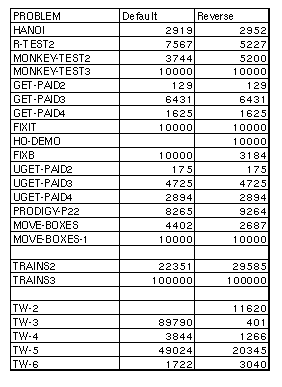 gives the second worst node count for
all such problems. It shows that, for all the basic problems in which at
least one strategy failed, and at least one other succeeded, the
second-worst strategy generally created fewer than 7000 nodes.
gives the second worst node count for
all such problems. It shows that, for all the basic problems in which at
least one strategy failed, and at least one other succeeded, the
second-worst strategy generally created fewer than 7000 nodes.
For the data collected using a node limit, we examined all the
problems in which at least one of the strategies hit the node
limit.
Table  gives the second worst node count for
all such problems. It shows that, for all the basic problems in which at
least one strategy failed, and at least one other succeeded, the
second-worst strategy generally created fewer than 7000 nodes.
gives the second worst node count for
all such problems. It shows that, for all the basic problems in which at
least one strategy failed, and at least one other succeeded, the
second-worst strategy generally created fewer than 7000 nodes.
Similarly, for the Trains and Tileworld problems, in all such cases except TW3, the second-worst strategy took fewer than 50,000 nodes (and in TW3 it took 89,790). Recall that the node limit for the basic problems was 10,000 nodes, while for the Trains and Tileworld problems it was 100,000 nodes. It is thus clear that the strategies that hit the node limit are doing substantially worse than the strategies that succeed. Even if they were to succeed by increasing the node limit slightly, their comparative performance would still be poor.
Thus, by using the node limits we imposed, we are not making any strategies look worse than they actually are. On the other hand, in computing %-overrun, we may be making some strategies look better than they actually are, because we use a value of 10,000 (or 100,000) nodes generated when a strategy hits the limit, and the actual number of nodes it might take, if run to completion, could be significantly higher. This is why, in our analyses, we considered both the absolute performance of strategies on individual problems, and their aggregate performance, as measured by average %-overrun.

We also compared the experiments that were run with a time limit and those that were run with a node limit. For the basic problem set, the time limit of 100 seconds was high enough that, in most cases, strategies could compute significantly more nodes than they could with the node cutoff. Nonetheless, the results were almost identical. In nearly all cases, if a strategy failed with the node cutoff, it also failed with the time limit cutoff. There were only four exceptions to this:
There was a similarly strong correspondence between the results we obtained on the Trains and Tileworld problems using a node limit and a time limit. In a few cases, a strategy that was able to succeed within the 100,000 node limit was not able to succeed within the 1,000 second time limit. The nature of these problems is that the computation time per node can be very great. Specifically,
Given this close correspondence between the experiments with node and time limits, we collected only node-limit data for the experiments in which we reversed the precondition insertion.